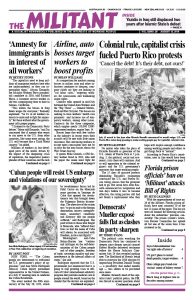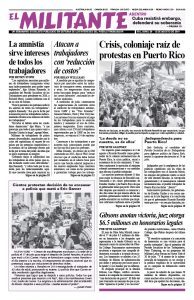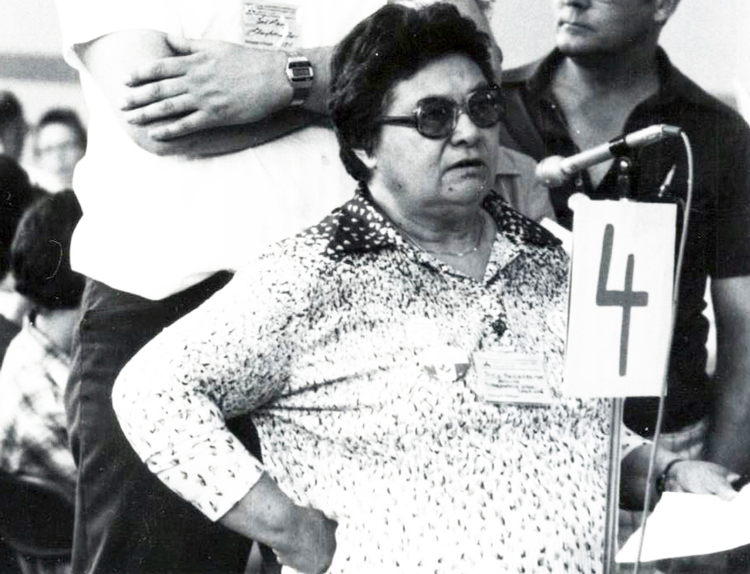MONTREAL — “Joyce Meissenheimer had so much confidence that she and those she fought alongside were on the right side of history,” explained Communist League leader Beverly Bernardo at a July 20 celebration of the life of Meissenheimer, a 54-year cadre of the Communist League in Canada and a fighter for over two decades against the apartheid regime in South Africa.
Born in Cape Town, South Africa, in 1922, Meissenheimer died on June 7 at the age of 96 in Calgary, Alberta. The celebration was attended by over 40 people.
“Meissenheimer’s political activity began when her father took her to a rally against racial segregation in 1937 when she was 15 and to meetings where she began to study Marxist books,” Bernardo explained. Meissenheimer grew up under the authority of the Colored Affairs Department, one of the bodies used by the government to deprive non-Caucasians of political rights.
Bernardo described how in 1948 at the age of 26, Meissenheimer became the editor of the Torch, the weekly newsletter of the Non-European Unity Movement, which exposed the injustices of the apartheid regime.
The Torch campaigned against the banning of members of the African National Congress. Meissenheimer herself was “banned” in 1961 — meaning she could not legally meet with more than two people, other than family members.
Facing these restrictions, she moved to Vancouver, British Columbia, in 1965 with her husband and four children where she joined the League for Socialist Action, a forerunner of the Communist League.
Party building in Canada
As a cadre of the LSA, Meissenheimer helped advance the party’s work in defense of the Cuban Revolution, its participation in the movement against the war in Vietnam, the struggle to repeal Canada’s restrictive abortion law and the fight against the use of the War Measures Act by the federal government in 1970 to try to crush the mass movement for Quebecois national rights.
Meissenheimer helped lead the 1977 fusion of the LSA with the Revolutionary Marxist Group and Groupe marxiste révolutionnaire to form the Revolutionary Workers League, “a qualitative strengthening of communist forces in Canada,” Bernardo explained.
“The struggle Joyce was a part of in South Africa was a cause very important to both of our parties,” explained Joel Britton, Socialist Workers Party candidate for mayor of San Francisco, who addressed the meeting on behalf of the SWP.
“The solidarity we extended to that fight was part of our duty as internationalists, and the support we enjoyed from South African revolutionists who were leading that struggle was a welcome contribution to the class struggle in North America,” he added.
“In the late 1970s, communists in the U.S. and Canada took steps to get the big majority of our parties’ members into jobs in basic industry where we could be members of industrial unions,” said Britton.
“Together with others we organized solidarity with revolutionary struggles in Iran, Grenada and Nicaragua,” he told the meeting. “And we helped mobilize support for the South African freedom fight from within our unions.”
Meissenheimer was fully supportive of the party’s turn to industry. “Joyce was a member of the Communist League branch in Montreal until 2001,” said Bernardo, when deteriorating health forced her to move to British Columbia.
‘A life worth living’
“Joyce embraced the life of a communist fighter to the fullest. It was her way to have a life worth living. I invite you to follow Joyce’s path and join the Communist League,” Bernardo concluded.
Pierre-Luc Filion, the Communist League candidate for the October federal election in the constituency of Longueuil-St.-Hubert, said that he never met Meissenheimer but he valued “the political legacy she left, that shows the kind of leadership needed to build the Communist League today.”
Filion described his campaign’s activities from extending the interest in the party and its program by campaigning door to door and introducing the Militant and revolutionary books to working people, to building solidarity with ongoing union struggles, like the weeklong strike for $15 an hour by workers at residences for seniors.
Primary school teacher and union activist Jennifer Alves Nadeau attended the meeting and told the Militant that “what Joyce did with her whole life is very impressive and encourages us to keep fighting today.”
A collection to help fund the work of the Communist League raised $1,740.
Messages from those who knew and worked with Meissenheimer from different countries were available to read in a bound volume at the meeting.
After the event many participants continued the celebration at a nearby restaurant in the spirit of Meissenheimer who often invited others to her place for a good meal, something to drink and a lively political exchange.


